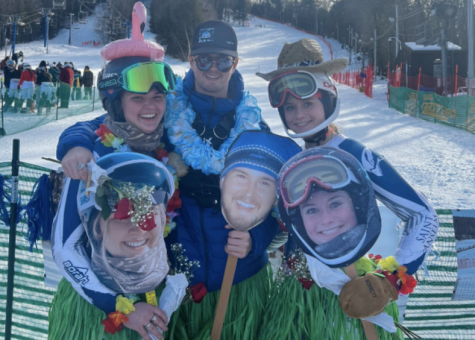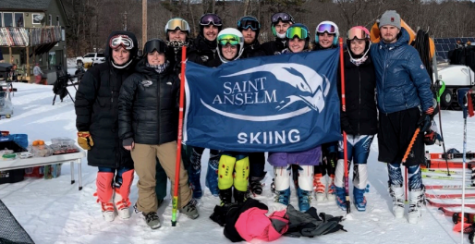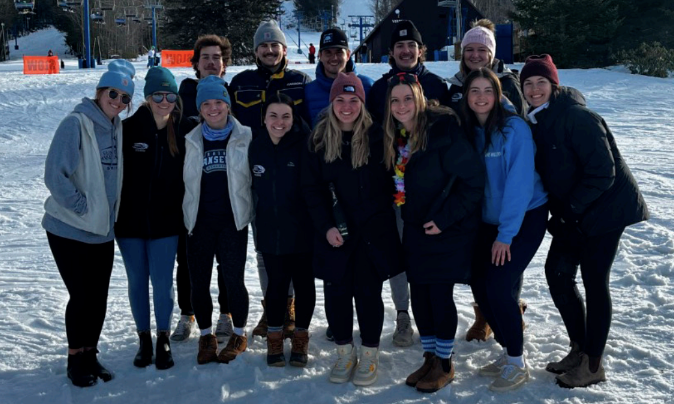Hawk ski team, led by ’21 alumna, hits the slopes at Pat’s Peak
The 13 ski team members pose for a group photo at the senior race at their home mountain — Pats Peak. (Courtesy / Shelly Juneau)
April 3, 2023
Meet the Saint Anselm ski team — a group of 13 skiers who train hard, compete at a high level, and love having fun.
The Saint Anselm ski team rosters four men and nine women — freshmen through seniors. Saint Anselm alum, Merry Curtis (‘21), coaches the ski team. The team trains at Pats Peak in Henniker, New Hampshire. For competitions, this is the home mountain for the Hawks, New England College, and Babson College.
The Hawks ski within the United States Collegiate Ski and Snowboard Association (USCSA) under the McConnell Division, which is the most competitive non-division I league in the northeast.
Castleton, Clarkson, UConn, UMass Amherst, Brown, Babson, and MIT join the Hawks in the McConnell Division. Some of the teams in the McConnell Division are varsity sports and some are club sports, which is incredibly unique.
The Hawks, UConn, UMass, and MIT are club teams, while the rest are varsity. Castleton also won the division II nationals in California this past season.
The Hawks came to campus on January 4 for their preseason. And the Hawks stayed on campus for their first weekend competition, which was in New Hampshire. The team opened their season, competing in a FIS race at Proctor Ski Area.
The Hawks hit the road for the next three weekend competitions, which were about four hours away in New York. The Hawks travel as a team and stay together at Airbnb’s, so as you’d imagine, the team spends lots of time together and has built an unbreakable bond. The team loves having fun, like cooking meals together and watching movies together.
The Hawks finished the season with their home race at Pats Peak.
Each competition has two races, slalom (SL) and giant slalom (GS). Slalom has smaller gates and tighter turns, whereas GS has paneled gates and wider turns. These races span across two days, and each race consists of two runs.
Every skier has their favorite ski memory. And some of the members of the Hawks team have been skiing since two years old, so they have lots of memories.
Senior Tony Demasi mentioned that, “I went to my home mountain this past weekend for the pond skim, which is where you ski across the pond. I saw everyone I knew growing up. It’s kind of like a celebration at the end of the year. It was like we didn’t skip a beat, and we all caught up with each other very easily. It’s really cool seeing all the people you know. I’ve met some of my best friends through skiing.”
Senior Brooke Juneau added that, “Skiing is something you can do forever. It’s a lifelong sport. And after having a bad day, skiing was my complete stress reliever because you’re outside, in the fresh air, just ripping down the mountain.”
Members of the team agreed that skiing is a very challenging physical sport. Skiing can be extremely dangerous, and the Hawks experienced a few serious injuries this past season. Flying down a hill at speeds near 30 mph and ripping around tight corners takes a lot of skill and a lot of guts.
But Juneau mentioned that the mental challenge of skiing often gets overlooked. Skiing is similar to cross country and track and field in the sense that they are all team sports but rely on individual scores. Essentially, the better you score as an individual, the better the team does. So in this way, there is a very individual aspect about skiing.
“All the pressure is on you if you want to do well. And if you don’t do well, you feel like you didn’t live up to the standard, which is kind of hard,” said Juneau.
Another thing that most people don’t know about skiing is just how much time and preparation goes into the sport.
“I think something we discuss as a team is how much time it takes up versus other sports. Just getting to Pats Peak, where we train, takes 45 minutes. Then we train there for two hours and have a 45 minute drive back. Then there’s lots of traveling every weekend for competitions, and we have to sharpen our skis, which can take a good two hours. There’s just a lot of time that goes into ski racing, and I don’t think a lot of people understand that,” said Juneau.
Demasi added, “You have to prep your equipment, and there’s a lot of driving. Every other varsity team has the fields right there. When they’re done with practice, they just go to the locker room and it’s like 100 feet away. With skiing, you have to change out in the lodge and then you have a long drive home.
During the season, the team skis every single day. The team trains every night that they’re not at a competition, so typically five nights a week, and they compete two days on the weekend. Each weekday after classes, the Hawks drive 45 minutes to Pats Peak for practice. That’s a packed schedule. So much work goes on behind the scenes that people aren’t aware of.
The ski team certainly puts a ton of time, effort, and dedication into their sport. They are a very hard working, closely knit crew who knows how to have a good time.

(Courtesy / Shelly Juneau)

(Courtesy / Shelly Juneau)



